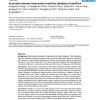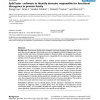BMCBI
2005
14 years 10 days ago
2005
Background: The identification of unique proteins at different taxonomic levels has both scientific and practical value. Strain-, species- and genus-specific proteins can provide ...
BMCBI
2005
14 years 10 days ago
2005
Background: The majority of residues in protein structures are involved in the formation of helices and -strands. These distinctive secondary structure patterns can be used to rep...
BMCBI
2005
14 years 10 days ago
2005
Background: The sequencing of the human genome has enabled us to access a comprehensive list of genes (both experimental and predicted) for further analysis. While a majority of t...
BMCBI
2005
14 years 10 days ago
2005
Background: Recognition codes for protein-DNA interactions typically assume that the interacting positions contribute additively to the binding energy. While this is known to not ...
BMCBI
2005
14 years 10 days ago
2005
Background: Current protein clustering methods rely on either sequence or functional similarities between proteins, thereby limiting inferences to one of these areas. Results: Her...
BMCBI
2005
14 years 10 days ago
2005
Background: The PD-(D/E)XK nuclease superfamily, initially identified in type II restriction endonucleases and later in many enzymes involved in DNA recombination and repair, is o...
BMCBI
2005
14 years 10 days ago
2005
Background: Normal mode analysis (NMA) has become the method of choice to investigate the slowest motions in macromolecular systems. NMA is especially useful for large biomolecula...
BMCBI
2005
14 years 10 days ago
2005
Background: Most proteins function by interacting with other molecules. Their interaction interfaces are highly conserved throughout evolution to avoid undesirable interactions th...
BMCBI
2005
14 years 10 days ago
2005
Background: Many protein families have undergone functional divergence after gene duplications such that current subgroups of the family carry out overlapping but distinct biologi...
BMCBI
2005
14 years 10 days ago
2005
Background: Protein function is often dependent on subsets of solvent-exposed residues that may exist in a similar three-dimensional configuration in non homologous proteins thus ...





